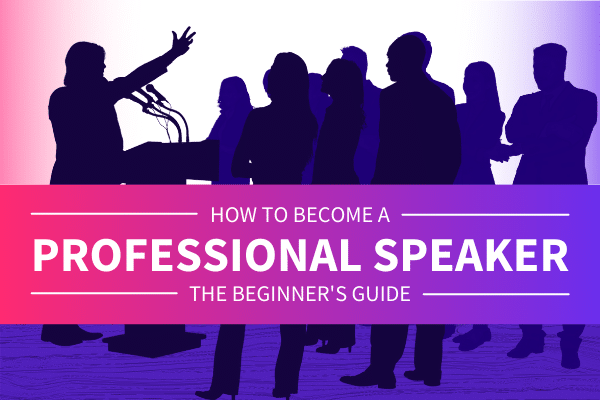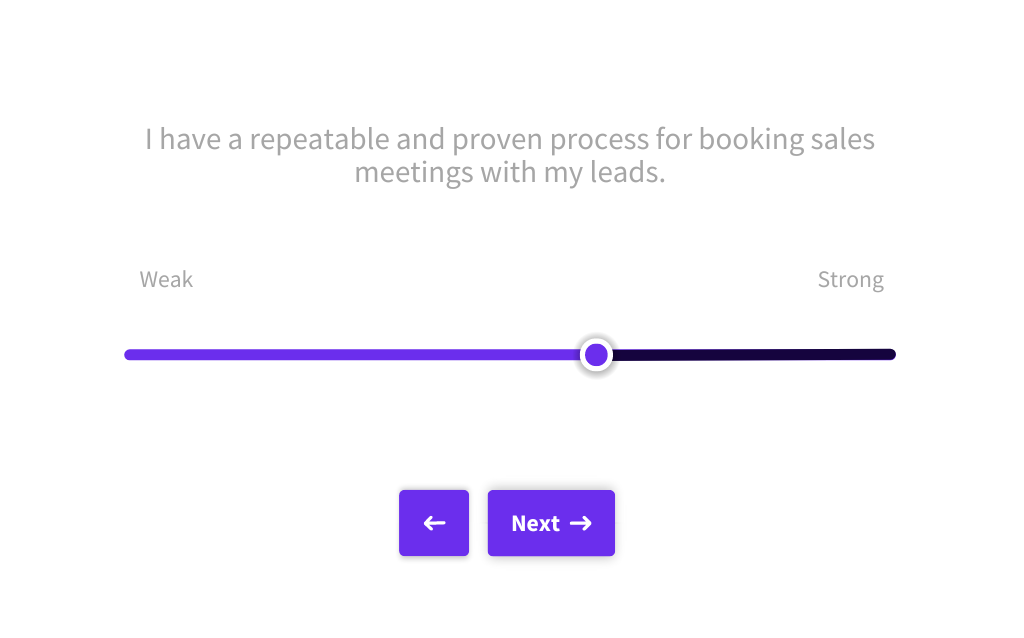As occupations go, working as a professional speaker can seem like the dream job at first glance. Even if you’re uncomfortable on stage, there’s the acclaim, attention, and travel that comes with speaking, not to mention the money. However, beneath this shiny facade, working as a professional speaker is a lot of work, and starting a speaking business is no easy feat. For many aspiring speakers, this begs the question, “How do I become a professional speaker as efficiently and painlessly as possible?”
In the broadest sense, becoming a professional speaker involves three major hurdles. First, you need to define which audience(s) you can serve and how you can serve them. After that, you need to hone your sales and marketing skills in order to build your personal brand. And, lastly, you need to continually advocate for yourself in order to command the speaking fees you truly deserve.
Depending on your past experiences – and your current occupation – some of these hurdles may be more easily overcome than others. But, as you continue to weigh your options, the following guide should provide at least a little clarity around the speaking profession. That way, you can move forward with tenacity, whether you choose to pursue speaking or not. 👍
- What is the role of a professional speaker?
- What are the pros and cons of being a professional speaker?
- How do I become a professional speaker?
- Summarize your professional and personal backstory.
- Pinpoint your ideal audience(s).
- Explain what problems you solve and how.
- Assemble your branding materials.
- Keep connecting with other experts as you grow.
- Edit or eliminate strategies and tools that don’t work.
- Remember your worth, and charge accordingly.
- Additional Resources for Aspiring Professional Speakers
What is the role of a professional speaker?
Before we dive into the details, let’s first break down the definition of a professional speaker. Unlike many occupations, the term “professional speaker” covers a wide range of roles and varying degrees of experience. For example, professional speakers can speak part-time (on top of another day job) or full-time, and they can speak in almost any industry on any topic. They also can have anywhere from zero past speaking experience to a degree in the subject. In other words, almost anyone who wants to be a professional speaker can be, as long as they put in the work (but we’ll get to that later).
Because of this variation, there’s also a variety of responsibilities under the “professional speaking” umbrella. If you purely want to be on stage, for instance, you can choose to deliver keynote speeches, breakout sessions, or even performances (standup, hypnosis, etc.). On the flip side, if you want to provide additional, complementary services, you can do that, too. A few common examples of such services include consulting, executive coaching, company workshops, and online coursework.
In short, although the essential role of a professional speaker is to provide clarity and motivation for their audience, the methods in which to do this are endless. In your own speaking business, the choice is entirely up to you and the needs of your target audience.
What are the pros and cons of being a professional speaker?
In addition to the responsibilities of professional speakers, it’s also important to consider all of the pros and cons. Although it’s always a good idea to connect with established speakers directly – through social media, speakers associations, etc. – below are a few of the most common pros and cons we’ve heard in working with speakers since 2019.
Pros of Professional Speaking
To start, let’s tackle the pros of being a professional speaker. Overall, professional speaking is an overwhelmingly positive experience for a number of reasons. For one thing, as mentioned above, there are no restrictions on who can become a speaker, including in regards to age, race, nationality, or gender. Over the last decade, especially, this has made the speaking industry increasingly diverse.
From a personal standpoint, speaking can also be incredibly rewarding. After all, you get to share your passions with thousands of people around the world, and explore in the process (assuming you have time during your trip).
Even if you don’t have time – or if it’s safer or more economically feasible to work from home – you can speak virtually. That way, even if the world slows down for a while, like during the COVID-19 pandemic, you don’t have to.
And finally, professional speaking is notoriously lucrative. For a single speaking event, even a relatively new speaker can command $1000 or more. Past that point, as you expand your speaking skills and sales offerings, you can charge multiple times that number. Some experienced speakers even charge upwards of $30,000! In your own speaking business, as long as you’re providing value for your clients and exceeding their expectations every time, you can do the same.
Cons of Professional Speaking

Unfortunately, not every aspect of running a speaking business is fun and games, bringing us to the “cons” section of professional speaking. As a new speaker, there are two large cons that you’ll face, starting with the sheer difficulty of getting a business off the ground. The speaking industry is no exception when it comes to entrepreneurship. So, before you start a speaking business, be well aware that you’ll be handling 99% of its operations yourself, working long hours, and making little if any profit for the first few years.
The second con new speakers face is the challenge of paid versus free speaking gigs. Initially, many speakers pitch their services for free in order to gain exposure and build their speaking skills, but this can turn into a trap when those speakers make a habit of it. Essentially, because they sell their services for free for a prolonged period of time, they end up believing that’s what they’re worth. Then, when they want to charge more, they don’t have the sales confidence to do so (hence, the trap). When and if you choose to start a speaking business, keep this in mind and stick to a plan of steadily increasing your fees over time.
Lastly, whether you’re a new or experienced speaker, the final con you should know is the time required. Although virtual speaking is becoming increasingly popular, live events remain the preferred method of delivery for the majority of event organizers and attendees. Consequently, as you book more and more gigs, you’re likely to be on the road for much of the year. If you’d prefer to spend more time with friends and family or if you simply prefer to avoid travel, consider this con when you decide whether or not to become a full-time speaker.
How do I become a professional speaker?
At this point, we’ve covered most of the basics. The one thing we haven’t talked about is how to become a professional speaker, including the critical steps to help you hit the ground running. With that in mind, the following seven steps – summed up with the acronym “SPEAKER” – outline the most common actions taken by successful professional speakers. Even if you’re started without speaking experience, follow this path, and you’ll be building a speaking career in no time.
Summarize your professional and personal backstory.
The first step to becoming a professional speaker is determining your story. From a neurological standpoint, storytelling has long been known to boost listener comprehension and retention. In recent years, a study by Princeton University neurologist Uri Hasson even showed that as we listen to a story, our brain waves synchronize with those of the storyteller, and the better our comprehension the more exact that synchronization.
Additionally, a message in the format of a story is more likely to alter the listener’s preconceptions or biases about the subject of the story. In other words, using your story in your speeches doesn’t just help listeners remember what you said. It also makes them more likely to absorb your message and put it into action long after you’ve left the stage.
So, how do you define your story? To hear speaker Brian Tracy tell it, “Every experience in your life is being orchestrated to teach you something you need to know to move forward.” Looking back on your own life – personal and professional – think about what’s brought you where you are today. What makes you stand out? Which experiences shaped your beliefs and taught you something? And which experiences led to changes in your decision-making and value throughout your life?
All of these details combine to make your story, and the more clearly you’ve defined your story, the more easily you’ll be able to communicate it with others.
Pinpoint your ideal audience(s).
After summarizing your story, the next step is to narrow down your ideal audience(s). As effective as storytelling can be when the listener is actively engaged, as a professional speaker, you’re very rarely (if ever) going to present to a single person. More often than not, you’ll present to an entire room of people or, at the very least, a team. Therefore, your story can’t be tailored to connect with that one person. It has to be broad enough that everyone in the room can relate.

To ensure that this is the case with your speeches, consider your story as it relates to different groups. Maybe your passion is gender equality and you want to speak to corporate groups. Maybe you’re all about entrepreneurship or the trades, and you want to speak in high schools. In any case, look for audiences that can relate to and benefit from your message and focus on speaking opportunities in those industries or areas of focus.
As the late entrepreneur, author, and speaker Jim Rohn once said, “The goal of effective communication should be for listeners to say ‘Me too!’ versus ‘So what?’” As you narrow down your focus to a few groups or industries, keep this in mind. Then, as your business grows and you’re able to collect feedback, pay attention to your successes. You may find that your story is engaging and relatable to an audience you didn’t even think about, initially.
Pro Tip: Focusing on a handful of audiences also ensures that you don’t spread yourself too thin. If you try to appeal to every audience, you’ll dilute your message so much that it doesn’t apply to anyone specific anymore. Remember you can’t please everyone. Instead, focus on a few audiences and serve them exceptionally well.
[hubspot type=cta portal=5815852 id=4423b6b8-d7d0-4f03-b792-184db7c3284b]
Explain what problems you solve and how.
The next step, after defining your audience(s), is clarify what problems members of these audiences face and how you’re going to help. Looking back at your story, think about lessons from your experiences and how they relate to your audiences. Ask yourself, “What problems did I face and what obstacles did I overcome?” Then, consider what similar problems members of your target audiences are facing right now.
Put simply, your goal is to demonstrate to potential clients that you understand what they’re going through and what their goals are. From there, your job is to prove that you can help them tackle those problems or goals, either through a speaking program or one of your other services.
One speaker exceptionally familiar with this concept is superfan expert Brittany Hodak. According to Brittany, “The secret to creating superfans is to connect your story with every customer’s story… If you can show them that you’re satisfying a sincere need, they won’t be searching for something (or someone) else to solve it.”
In terms of speaking, the same principle applies. Regardless of your focus or speaking experience, thought leadership always comes down to solving problems. It can be through tangible materials, like coursework or books, or intangible resources, like speaking events. But, whatever the medium, it should always be solution-oriented.
Assemble your branding materials.
Step #4 of becoming a speaker takes all of the above details and makes them polished and professional. If you haven’t guessed it already, I’m talking about taking your prepared materials and designing them as a personal brand.

Unlike a company or organizational brand, a personal brand encapsulates… well, you! As the name suggests, it’s personal, so it not only meets the goals of a “regular” brand (building name recognition, providing a consistent and professional image for your business, etc). It also communicates, to the viewer, what makes you unique and better equipped than your competitors to tackle their event or project.
To set up your personal brand, if you haven’t already done so, it’s important to act with a few basic branding principles in mind. Below are my top recommendations:
- Keep it simple. Modern branding calls for clean-cut, confident colors, fonts, and lines. When planning your brand, stick to a defined style, so you’re not using too many at once.
- Be consistent. Every aspect of your business should use the same colors, fonts, and design style. Where appropriate, remember to include your logo, too, so viewers can easily recognize your materials.
- Be authentic. Stick to branding elements that feel “right” and represent you, as a person. If you try to present yourself as someone you’re not, your audiences will be able to tell. It is a personal brand, after all, so just be yourself!
These are just a few of the many design tips and trends to remember as your plan your personal brand. For additional information specific to branding, I highly recommend 99Design’s guide, “Personal Branding Secrets: 7 Steps To Building An Outstanding Personal Brand,” or Canva’s “The Complete Guide To Personal Branding.”
Keep connecting with other experts as you grow.
Besides compiling the tangible aspects of becoming a professional speaker, one of the most valuable things you can do is connect with other speakers. Compared to other industries, the speaker market has stayed relatively consistent in many ways. High-quality stagecraft, for example, continues to call for familiar, “tried-and-true” speaking tactics, like using humor to lighten dark subjects and ending with a clear call to action.
However, behind the scenes, many of the aspects of running a speaking business are in constant evolution. Depending on who you ask and how long they’ve been working in the industry, you may receive a different answer for common questions like, “How can I easily find paid speaking opportunities?” or “How do I market myself as a speaker?”
Because of this variety, it’s vital that you network as much as possible. In the speaking industry, connect with speakers at association events or local chapter meetings. Also, make the most of free discovery calls with industry professionals like SpeakerFlow, who meet with hundreds of speakers on a weekly basis. The more you can get to know people within the industry, the better you can stand out in it.
Additionally, within your focus industries, network with thought leaders or industry experts that were there before you. Ask about their experiences, their advice, and the trends they’re seeing. Then, combine their insights with those of your speaking connections, so you can make a name for yourself as a speaker and an authority in your focus industry(ies).
Edit or eliminate strategies and tools that don’t work.

Step #6 of becoming a professional speaker is a simple one: consistently test all strategies and tools in your business. While keeping on top of industry-wide trends is undeniably important, it’s also valuable to consider trends within your business alone. In sales, for example, when you get regular business from an industry outside of your target market, you look at that industry in more detail. If your sales language isn’t successful, you make adjustments to test out new sales language.
In either case – good and bad – the idea is to be on the lookout for change at all times. As renowned motivational speaker Les Brown said, “You cannot expect to achieve new goals or move beyond your present circumstances unless you change”. In other words, in speaking as in life, if you’re not willing to change, your business won’t grow. Even if it’s uncomfortable or daunting, remember that every speaker and every speaking business is a little different. Just focus on testing different strategies and finding what works best for you, specifically, and success will come.
Remember your worth, and charge accordingly.
Last but not least, if you want to become a successful professional speaker, always remember your worth. All too often, among our clients and connections in the speaking industry, we see speakers underselling themselves. Among these speakers, few common explanations are, “I’m just not confident selling my services,” “I don’t feel comfortable raising my fees even though I need to,” and “I’m unsure of the baseline fee for offerings like mine.” Even though they know they’re worth more than they’re charging clients, they don’t know how to solve the problem.
Though all of these reasons are justified in an emotional sense – after all, entrepreneurship is a grind – they’re not reasons to undercut your own success. As a thought leader, your insights, products, and services all have an impact on your audience, and, in most cases, that impact is unique to you. Simply put, hiring another speaker won’t provide the same level of engagement, entertainment, and inspiration as you would, making your words worth a great deal, even if you’re new to the professional speaking game.
Knowing this, when you’re building your reputation and your business as a professional speaker, shoot high. As psychologist Amy Cuddy said in her 2012 TED Talk, “Don’t fake it till you make it. Fake it till you become it. Do it enough until you actually become it and internalize”. Even if you’re not confident in your worth or your sales abilities now, just fake it. Before you know it, not only will you have more assurance in your worth, but potential clients will, too.
Additional Resources for Aspiring Professional Speakers
Ultimately, the path to becoming a professional speaker can be winding, but the end result can be incredibly rewarding. Take it from our team – having worked in dozens of other industries and now focused solely on the speaking industry, there’s no place we’d rather be.
For more information about becoming a professional speaker, subscribe to our blog and check out our weekly podcast, Technically Speaking. A few of our most popular episodes are listed below, so you can start with what’s most impactful.
- “3 Reasons Why You’re Not Getting The Fees You Deserve” with David Newman
- “The Power Prospecting: Everything You Need to Know” with Sam Richter
- “The Journey of a Million-Dollar Speaker” with Simon T. Bailey
- “What It Takes To Be A 7-Figure Speaker” with James Taylor
Additionally, for more hands-on guidance – and a massive, regularly updated library of resources – join SpeakerFlow University! With exclusive content and a lot of camaraderie, SFU’s all about providing support and reliable information so thought leaders can change the world more efficiently. Check out our University page for more information or shoot us an email with any questions.
In the meantime, best of luck on your path to becoming a professional speaker! Looking forward to seeing you on stages throughout the industry sometime soon! 😊






